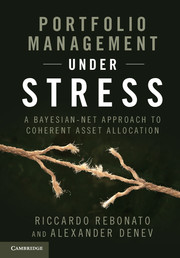Book contents
- Frontmatter
- Dedication
- Contents
- List of figures
- List of tables
- Acknowledgements
- Part I Our approach in its context
- Part II Dealing with extreme events
- Part III Diversification and subjective views
- Part IV How we deal with exceptional events
- 11 Bayesian nets
- 12 Building scenarios for causal Bayesian nets
- Part V Building Bayesian nets in practice
- Part VI Dealing with normal-times returns
- Part VII Working with the full distribution
- Part VIII A framework for choice
- Part IX Numerical implementation
- Part X Analysis of portfolio allocation
- Appendix I The links with the Black–Litterman approach
- References
- Index
11 - Bayesian nets
from Part IV - How we deal with exceptional events
Published online by Cambridge University Press: 18 December 2013
- Frontmatter
- Dedication
- Contents
- List of figures
- List of tables
- Acknowledgements
- Part I Our approach in its context
- Part II Dealing with extreme events
- Part III Diversification and subjective views
- Part IV How we deal with exceptional events
- 11 Bayesian nets
- 12 Building scenarios for causal Bayesian nets
- Part V Building Bayesian nets in practice
- Part VI Dealing with normal-times returns
- Part VII Working with the full distribution
- Part VIII A framework for choice
- Part IX Numerical implementation
- Part X Analysis of portfolio allocation
- Appendix I The links with the Black–Litterman approach
- References
- Index
Summary
If people do not believe that mathematics is simple, it is only because they do not realize how complicated life is. John von Neumann
One of the core ideas at the heart of our approach is to treat separately ‘normal’ and ‘exceptional’ events. We begin with the latter, because herein lies the more original part of our work, and both we and reader are therefore understandably eager to start in earnest.
There is, however, another reason for starting from the ‘excited’ component. Paradoxically, defining and handling the ‘normal’ part of the problem (and, quantitatively, the joint distribution of returns) is surprisingly subtle and far from unambiguous. So, starting from the tails can be conceptually, if perhaps not technically, easier. We address the ‘subtle’ issues we have just referred to in the opening pages of Section 17.1. We invite the reader to ponder those pages carefully.
In this chapter we introduce Bayesian nets. As we shall see, in the narrowest sense Bayesian nets are a tool to obtain (factorize) the joint probabilities between a number of (discrete) variables. In general, Bayesian nets need not be endowed with a temporal or causal interpretation. However, when such an interpretation is adopted (and warranted!) Bayesian nets become particularly powerful tools – tools, that is, that can aid and enhance our understanding of a problem; that, when used subjectively, we can implement with confidence; that can help us avoid logical mistakes; and that, by pushing any assumptions we make to their ultimate logical consequences, tell us if we are ‘thinking straight’.
Information
- Type
- Chapter
- Information
- Portfolio Management under StressA Bayesian-Net Approach to Coherent Asset Allocation, pp. 105 - 135Publisher: Cambridge University PressPrint publication year: 2014
